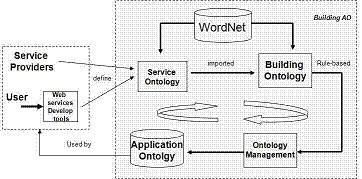That paper below was written by Doug Foxvog (of this list)
among others; it has an interesting overview algorithm section around the third
page or so:
6.
Building Application Ontologies
In
order to build meaningful a (AO),
a knowledge base,
a
thesaurus or dictionary is necessary. WordNet is a quite
mature
conceptual thesaurus with hierarchally structured
organisation
and multiple semantic relations between concepts.
It
is a good choice also due to its broad concept structure
of
synonym sets.
6.1
Process of Building (AO)
We
assume there are k
semantic services from the same
application
domain as the inputs of (AO) builder.
As depicted
in
Fig. 4, the building process is iterative including
following
steps.
1.
Initialize AO0 as
an empty set, ;.
2.
Import a SOi; 1 · i · k; re-organise it into
the ontology
[ my note: 1 <= i <= k
]
structure
defined by Definition 1.
3.
For each concept of SOi, extract its relative
concept
information
from WordNet by the WCEA
algorithm of
Section
6.2; add the retrieved information to SOi, then
get
a new SO0i with more concept
relations.
4.
Merge SO0i and AOi¡1 using
the WOMA
algorithm
defined
in Section 6.3 to obtain a new AOi.
5.
Manage AOi,
including cleaning concept conflicts,
updating
and storing (see Section 6.4).
6.
Repeat steps 2 to 5, until i = k, then stop.
The
output of this process is an application ontology AOk,
which
can be referred to by other service providers or users
to
create new applications as depicted in Fig. 4.

This algorithm seems like a very useful
place to start from if the list wants to consider how ontologies might be
merged in daily practice.
-Rich
Sincerely,
Rich Cooper
EnglishLogicKernel.com
Rich AT EnglishLogicKernel DOT com
